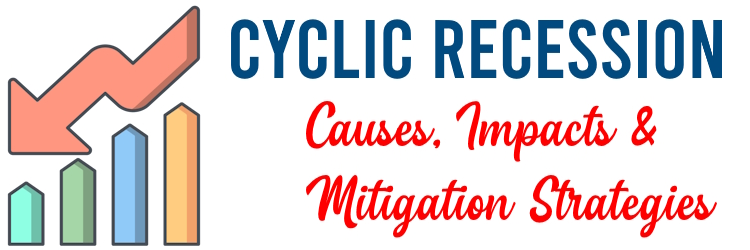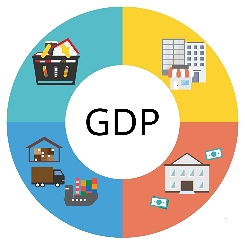Cyclical Recessions: Causes, Impacts, and Mitigation Strategies
The economy is a complex and dynamic system that experiences periods of expansion and contraction. Cyclical recessions are a natural part of this economic cycle, characterized by a decline in economic activity, widespread unemployment, and a decrease in business profits. Understanding the causes, impacts, and mitigation strategies associated with cyclical recessions is crucial for policymakers, businesses, and individuals to navigate these challenging times and foster economic resilience.

Table of Contents
- 1 Causes of Cyclical Recessions
- 2 Impacts of Cyclical Recessions
- 2.1 Unemployment and Income Loss
- 2.2 Reduced Business Investment
- 2.3 Financial Market Instability
- 2.4 Government Budget Constraints
- 2.5 Psychological and Societal Effects
- 2.6 Bankruptcies and Business Failures
- 2.7 Reduced Innovation and Research and Development (R&D)
- 2.8 Impact on Government Revenue and Public Services
- 3 Mitigation Strategies for Cyclical Recessions
- 4 Conclusion
Causes of Cyclical Recessions
Cyclical recessions are typically triggered by a combination of factors that disrupt the delicate balance between supply and demand in the economy. Some common causes include:
Business Cycle Dynamics
The business cycle inherently exhibits periods of expansion and contraction. After a prolonged period of economic growth, excesses and imbalances accumulate, such as inflated asset prices, overinvestment, and increased borrowing. These imbalances eventually lead to a correction, resulting in a recession.
Financial Crises
Financial crises, often fueled by excessive risk-taking and speculative behavior, can amplify the severity of a cyclical recession. The collapse of housing markets, banking failures, or bursting of asset bubbles can trigger a domino effect, causing widespread economic turmoil.
Macroeconomic Policy Factors
Poor macroeconomic policies, such as inappropriate fiscal or monetary measures, can contribute to cyclical recessions. Misguided policies that fail to address economic imbalances or respond adequately to changing economic conditions can exacerbate downturns.
External Shocks
External factors such as geopolitical conflicts, natural disasters, or global health crises can trigger cyclical recessions. These shocks disrupt supply chains, decrease consumer and investor confidence, and create economic uncertainty, leading to a contraction in economic activity.
Inventory Accumulation
During periods of economic expansion, businesses may accumulate excessive inventories in anticipation of sustained demand. However, if demand unexpectedly weakens, businesses are forced to reduce production and adjust their inventories, resulting in a slowdown or recession, including cyclical recessions.
Decline in Consumer and Business Confidence
Consumer and business confidence play a vital role in driving economic activity. During times of economic uncertainty or negative sentiment, consumers tend to reduce spending, and businesses become cautious in their investment and hiring decisions. This decline in confidence can contribute to a cyclical recession.
Tightening Monetary Policy
In an attempt to curb inflation or address financial imbalances, central banks may implement tighter monetary policies by raising interest rates or reducing liquidity in the financial system, potentially triggering a cyclic recession.
Impacts of Cyclical Recessions
Cyclical recessions have far-reaching effects on various sectors and stakeholders within the economy. Some of the key impacts include:
Unemployment and Income Loss
During recessions, businesses face declining demand and may resort to cost-cutting measures, including layoffs and reduced working hours. Unemployment rates rise, leading to income loss and financial hardship for individuals and families. This, in turn, reduces consumer spending, further perpetuating the recessionary cycle.
Reduced Business Investment
Uncertainty and reduced profitability prompt businesses to postpone or cancel investment plans, which can have detrimental effects during a cyclic recession. This decline in investment negatively impacts economic growth and productivity, hindering long-term development.
Financial Market Instability
Cyclic recessions, are often accompanied by significant turmoil in financial markets. Stock market declines, credit crunches, and reduced access to capital can destabilize the financial system, leading to decreased business lending and weakened consumer confidence..
Government Budget Constraints
Cyclical recessions strain government finances as tax revenues decline and social welfare expenditures increase. Governments may face budget deficits, limiting their ability to implement expansionary fiscal policies and provide adequate support to affected individuals and businesses.
Psychological and Societal Effects
Cyclical recessions can have significant psychological impacts on individuals and communities. The fear of job loss, financial instability, and uncertainty about the future can cause stress, anxiety, and a decrease in overall well-being. Moreover, recessions can exacerbate social inequalities and lead to social unrest or political instability.
Bankruptcies and Business Failures
As economic conditions worsen during a recession, businesses may struggle to meet their financial obligations, leading to a rise in bankruptcies and business failures. This not only results in job losses but also disrupts supply chains and reduces competition in the market, further impacting the overall economic landscape.
Reduced Innovation and Research and Development (R&D)
During recessions, businesses often cut back on research and development expenditures and innovation initiatives to prioritize cost-cutting and survival. This reduction in innovation and R&D activities can have long-term implications, hindering technological advancements and stifling economic growth in the post-recession period.
Impact on Government Revenue and Public Services
Cyclical recessions can significantly impact government revenue streams, particularly from income and consumption taxes. This places strain on public finances, limiting the government’s ability to fund essential services such as healthcare, education, and infrastructure. Governments may be forced to implement austerity measures or increase public debt to bridge the revenue gap.
Mitigation Strategies for Cyclical Recessions
To mitigate the negative effects of cyclical recessions and promote a swift recovery, various strategies can be employed:
Monetary Policy
During cyclic recessions, central banks can implement expansionary monetary policies. These include reducing interest rates, providing liquidity to financial institutions, and engaging in quantitative easing. Lower interest rates stimulate borrowing and investment, spurring economic activity during recessions.
Fiscal Policy
Governments can use fiscal stimulus measures to boost aggregate demand and stabilize the economy during cyclic recessions. This can involve increasing government spending on infrastructure projects, providing tax cuts or rebates, and implementing targeted social welfare programs to assist the most vulnerable during the recessionary period.
Counter-cyclical Policies
Policymakers can adopt counter-cyclical policies that aim to moderate the extremes of the business cycle, including cyclic recessions. During periods of economic expansion, measures such as stricter lending standards and regulations can help prevent excessive risk-taking. Likewise, building fiscal buffers during economic booms can provide governments with the resources necessary to respond effectively during downturns, including cyclic recessions.
Support for Affected Sectors
Governments and industry bodies can provide targeted support to sectors most affected by cyclic recessions. This may involve offering subsidies, tax incentives, or loan programs to stimulate investment, innovation, and job creation in struggling industries. Such support helps to stabilize the affected sectors and promote their recovery.
International Cooperation
In an interconnected global economy, international cooperation is vital in mitigating the impact of cyclic recessions. Collaboration between governments and international organizations can help coordinate policies, stabilize financial markets, and promote trade, ultimately aiding in a synchronized recovery from cyclic recessions.
Job Retraining and Skill Development Programs
During cyclic recessions, job retraining and skill development programs become crucial. Certain industries may experience a decline in demand, resulting in job losses. To facilitate a smoother transition for affected workers, governments and businesses can implement job retraining and skill development programs. These initiatives aim to equip individuals with new skills that are in demand in emerging industries or sectors, increasing their employability and reducing the duration of unemployment during cyclic recessions.
Infrastructure Investment
During cyclic recessions, private sector investment often decreases, which can negatively impact infrastructure development. To counteract this, governments can increase public investment in infrastructure projects. These investments not only stimulate economic activity in the short term but also contribute to long-term growth and productivity. Infrastructure projects create jobs, enhance transportation networks, improve public utilities, and attract private investment, all of which are essential during cyclic recessions.
International Trade and Export Promotion
Expanding international trade becomes crucial during cyclic recessions. Governments can focus on promoting exports, reducing trade barriers, and diversifying export markets to increase competitiveness and offset declining domestic demand. Trade agreements and partnerships with other countries can help businesses access new markets and foster economic growth during cyclic recessions. However, it is essential to balance trade policies to ensure fair competition and protect domestic industries during cyclic recessions.
Conclusion
Cyclical recessions are an inherent part of the economic cycle, and understanding their causes, impacts, and mitigation strategies is crucial for managing their effects effectively. By implementing sound macroeconomic policies, providing support to affected sectors, and fostering international cooperation, societies can navigate through these challenging periods and work towards building a more resilient and stable economy.




